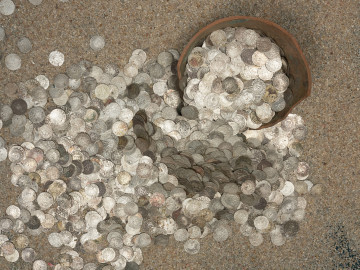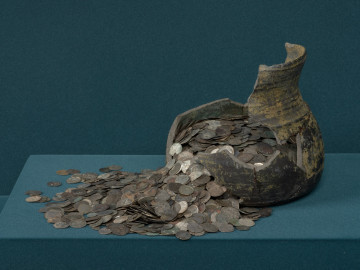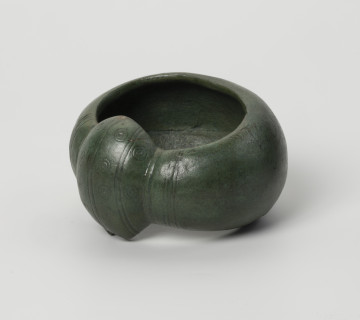
Treasure of coins
1507 — 1660
National Museum in Szczecin
Part of the collection: Treasures of coins from Western Pomerania
In 1997, an unusual numismatic discovery was made in Kamień Pomorski. During the construction works, a clay cooker tile was found, in which 656 Teutonic shillings and 2 German guilders from the 15th century were hidden. What draws attention is the vessel used for securing the coins and the structure of the treasure, which does not reflect the proportions of the deposits known from that period. In most cases, the admixture of Teutonic shillings did not exceed 10% of their content. In the Kamień hoard, the most numerous (440 pieces) were the shillings of Grand Master Paweł von Russdorf (1422-1441). The youngest coins which date the deposit are the gold guilders of Emperor Frederick III from 1491-1495. Despite the extensive range of coins in the hoard (nearly eighty years), its core was formed in the second quarter of the 15th century, i.e., during the period of the most significant decline in Teutonic minting after the defeat at Grunwald. The silver content of the coins was negligible, and counterfeits accompanied the 'bad' shillings. This phenomenon is represented in the deposit by a copper shilling by Michał Küchmeister (1414-1422) covered with a thin layer of silver, the so-called fourree, literally 'having copper underneath'. It was practised in official mints, in war situations, e.g., to pay soldiers. The treasure is proof of a long circulation of Teutonic sherds outside Prussia. Despite the twilight of the Hanseatic League and the impoverishment of townsmen, one of Kamień Pomorski residents hid in a tile an estimated equivalent of almost a year's income of a worker. It was not a large sum but could have sufficed for a barrel of wine or a poor horse and cart. It is worth mentioning that the recognisable iconography of Teutonic Order's shillings attracted their imitations. Pomeranian shillings of Duke Bogislaw X (1474-1523) were stylistically and metrologically modelled on the Teutonic ones.
Genowefa Horoszko
Author / creator
Dimensions
cały obiekt:
Object type
tile, coin
Technique
firing, minting, wheel rolling, forming
Material
copper, silver, ceramic
Creation time / dating
Creation / finding place
Owner
National Museum in Szczecin
Identification number
Location / status

1507 — 1660
National Museum in Szczecin

1290 — 1410
National Museum in Szczecin

900 p.n.e. — 550 p.n.e.
National Museum in Szczecin
DISCOVER this TOPIC
Castle Museum in Łańcut
DISCOVER this PATH
Educational path